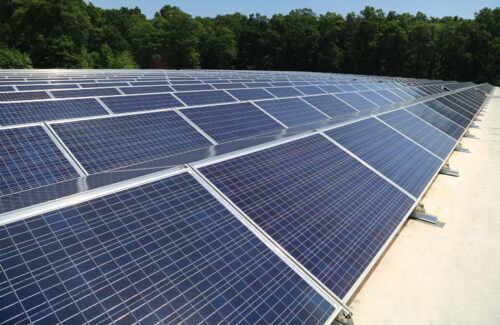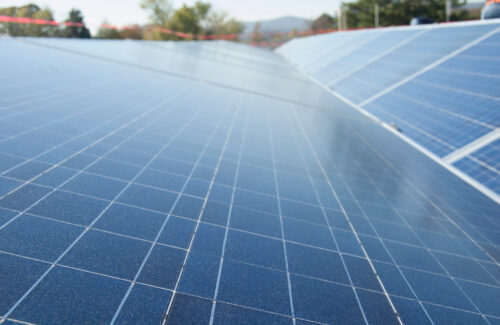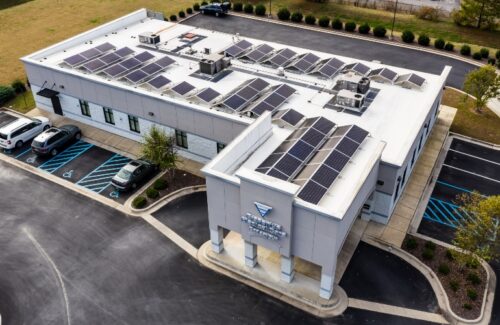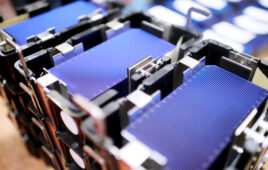It’s common for technologies to leave the solar market. The industry is constantly growing and changing, and not every manufacturer survives.
What’s uncommon is for a solar technology that’s been dormant for half a decade to resurface under a new name.
In 2017, solar racking and module manufacturer tenKsolar shuttered. Today, its technologies are available again from a new company called Global RAIS.
Greg Cox, co-founder and president of Global RAIS, and his business partner Todd Broome are responsible for reviving tenK’s proprietary interconnected-cell solar modules and kit-based racking. Cox is an environmentalist and former solar contractor who used the “dual-tilt” systems in the past, installing several projects using tenK technology on buildings belonging to Broome.

Credit: Global RAIS
tenK was founded in 2008 and shuttered nine years later. The manufacturer was known for its pre-packaged “wavelets” primarily installed in the commercial market. Solar panels, racking and microinverters were sold together as kits.
Many tenK systems began failing after deployment due to a microinverter manufacturing issue that caused water damage. One report said that in 2015, 100 installations in Minnesota alone were malfunctioning.
tenK was addressing the microinverter failures when it went out of business in 2017 for an unrelated issue. Global RAIS plans to help previous tenK customers replace faulty inverters with its current, compatible microinverters.
As tenKsolar was closing its doors, Cox was in the middle of several projects, so he acquired some of the company’s remaining product inventory.
“I was curious as to what was going to happen with the technology,” Cox said. “It was a really good technology, and I was sad to see it go away.”
So, he and Broome formed a company to purchase the intellectual properties belonging to tenK. By that point, tenK had ceased all operations, sold the rest of its inventory and laid off its employees. But the former owners still had possession of the technology’s IP and patents.
Cox and Broome pitched the former tenK owners on acquiring the technology, which included 30 patents relating to solar module and racking design. The pair officially acquired tenK’s IP in June 2019 and prepared to revive the dormant solar technology as soon as investors were secured. But then COVID-19 hit.
“COVID was actually a blessing in disguise for us, all of the devastation notwithstanding,” Cox said. “It’s allowed us to really rethink and strategize and position ourselves to be successful. Clearly, we’ve learned lessons from what tenK went through and we’ll not repeat some of the same processes. I’m a big believer in needing to walk before we run.”
Intentional panel shading
The company name Global RAIS is a reference to one of the key patents on tenK’s technology. It stands for “Redundant Arrays of Integrated Solar.” What differentiates Global RAIS’s solar panel technology is its solar cell structure.
“Rather than being serial-based architecture where every cell is connected to the next cell and so forth — and you build voltage as you add cells and add modules — this IP allows us to build everything in a matrix fashion,” Cox said. “So, each cell is connected to the next cell in multiple pathways.”
This means that individual cells in Global RAIS panels can still perform without hindrance from neighboring cells that are underperforming; whereas solar cells with typical connections can underperform if neighboring cells experience performance loss, like shading or microcracks.

Credit: Global RAIS
Global RAIS demonstrated the durability of its panels in a side-by-side test with a competing module brand by simulating shading and damaging the panels with a baseball bat, bullet holes and even by throwing a whole kitchen sink at each panel. Due to its parallel cell structure, the Global RAIS module continued to produce power throughout the test.
This ability to operate through shading and other obstructions is what makes Global RAIS panels suited for commercial rooftops with obstructions like HVAC systems casting shade throughout the day, Cox said. The company is so unconcerned with shading, Global RAIS’s system is designed to work with shadows.
The dual-tilt racking places panels back-to-back at 26° and 16° angles in each row. With those varied panel angles and the compact nature of the racking, inter-row panel shading is unavoidable during the day. But Global RAIS is betting that the ability to pack more panels onto a surface and mitigate that inevitable shading means these systems will outperform traditional arrays.
“It allows us to put a much higher density of potential energy generation in a smaller footprint because of the shading,” Cox said. “In traditional solar, you’ve got to account for that shading. We don’t need to deal with that, so we can pack a much higher amount of power in a smaller footprint.”
The system can be designed in east-west, north-south or any orientation off-azimuth, and it can be mounted to the ground. The panels and racking are sold together as one package and can’t be mixed and matched.
Global RAIS modules are currently using Northern Electric Power BDM-800 microinverters with customized firmware that adapts to their low-voltage output, but the company is exploring other collaborations too. DC-coupled storage integration is made simple with Global RAIS’s module-level electronics package, which features configurable voltage controls that eliminate the need for an additional battery management system.
“That storage-ready module, that’s a key component. If there’s one thing that’s really convinced us that we should come back to the market now, it’s this direct-to-storage piece,” Cox said.
Learning from past mistakes
Reviving a solar technology that left the industry years ago has made Cox reflect on the choices that led to tenK’s demise. He saw an opportunity to fill a niche in the market with this hardware that he loved enough to pursue the patents, but he also recognizes opportunities at an institutional level to operate differently.
Global RAIS is pursuing a B Corp certification, which will mean flattening corporate governance among employees, being transparent about the company’s performance and, of course, prioritizing sustainability within the company and all the way up the supply chain.
 The company is also planning to install solar systems for clients that provide critical public services during natural disasters, like food banks and medical centers.
The company is also planning to install solar systems for clients that provide critical public services during natural disasters, like food banks and medical centers.
“We seek to do good with this product, and we need to do good with this product in places where this is going to make a huge difference to how people live,” said Robin Cox, chief sustainability officer at Global RAIS. “In a lot of places, you need reliable, readily available clean energy, so the B Corp certification allows us to do that within the same corporate structure.”
After pursuing and acquiring the rights to a dormant solar technology, re-establishing manufacturing operations and emerging from a pandemic, Global RAIS solar modules and racking are a reality. The company has sold its first projects, but this is just the beginning of its re-entry into the solar market.
“We don’t have a magic mirror,” Robin Cox said. “We don’t know what the future holds, but we teach and learn better by doing it ourselves. As the company grows, our intent is to do it different and figure it out along the way.”





Greg, how do I contact you or could you email me? I have 16 ten k solar panels that are 8 years old. The inverters are failing so my production is significantly down. Can I purchase inverters from you? Thanks, John
Do you have a geotechnical protocol for the installations of your panels by chance? Pile load testing as well?
NEP collaboration is a red flag. They’ll need to find better partners if they’re prescribing/kitting inverters with their product. Microinverters as the main pcs in general (without additional support for traditional commercial inverters or optimizers) will severely limit this product’s market.
I’m interested in your perspective on microinverters. I you are willing to do so, please reach out to me directly. My contact information can be found at http://www.globalrais.com
I’m interested in your perspective on microinverters. I you are willing to do so, please reach out to me directly. My contact information can be found on our web site.
I can’t believe it – you folks are a godsend. I have been hoping that tenK would find it’s way back from the graveyard of good ideas! I have several megawatts worth of opportunities for resurrecting old tenK systems. Let’s talk!
Please reach out directly to me, Ralph.
Great to see this technology return. At the time one of the best advancements in solar panal design in decades.
I share your enthusiasm about this technology!!